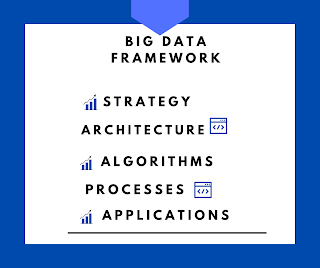Big Data Framework: Why Organizations Need Them
Need for big data framework
There is a need for a big data framework for businesses. Many organizations struggle in realizing the benefits of data or cannot establish an effective big data practice owing to a lack of models and frameworks to handle 'Big' data. However, there has been a paradigm shift within organizations that now use big data in order to streamline their operations. And this paradigm is being driven by new trends such as the Internet of Things (IoT) or an explosion of data that these trends bring about.
The number of things that can now become a part of the Internet is staggering.
Benefits of a framework
A framework is a systematic approach to attain the desired goal.
Big data framework - Big data framework are comprised of a set of tools to help companies process, visualize, and leverage their data for decision making.
- Big data framework helps in making the organization's decision-making easier.
- It ensures that the organization is able to find relevant information with ease
- It reduces wastage of time by making the organization efficient and effective at their job.
- Large amount of data can be utilized to provide strategic insights when coupled with formal and conceptual knowledge.
Big data demands a lot of skills. Even with the most advanced tools and technologies available globally, companies will be unsuccessful without requisite skills and knowledge. A framework seeks to address the skills gap by helping companies increase everyone’s knowledge in the big data industry.
Using a framework helps companies follow a holistic approach toward big data. It helps companies see various components that they should consider while setting up their information processes.
Structure of a big data framework
Such frameworks define six areas that companies need to consider while setting up their operations. The following are six areas:
Strategy - A fundamental element of any big data framework is a clear strategy. This is to ensure that organizations are able to seamlessly integrate big data into their existing systems, processes and tools. The strategy addresses how the organizations can use the big data for growing their business. The following are some aspects of the strategy:
- The strategy should outline the objectives and what type of insights companies aim to achieve using big data.
- The strategy addresses the process that companies will use to acquire and manage their big data.
- The strategy should outline how the organization will leverage the big data in order to help them reach the objectives.
Architecture - Big data frameworks are built based on an architecture that mirrors a process or the way that organizations work. Such frameworks help companies by ensuring that they have all of the necessary tools to execute any kind of solution using big data.
To store and analyze such a large amount of data, companies require large infrastructure. Enterprises and companies should have an infrastructure that can manage and scale operations as the number of information increases and facilitate convenient data processing and analysis.
This part of the framework essentially answers: how should companies design their infrastructure? What are the requirements for storing and processing such a huge amount of information?
Algorithms - Knowledge of algorithms is essential to build data processes. Algorithms are derived from statistics and mathematics. So, knowledge of statistics and mathematics is crucial to excelling in such technology. Algorithms can automate tasks, process reasoning, and derive insights from analysis.
Algorithms have been an integral part of data science since the first major use of computers. The following are some aspects of algorithms:
- Algorithms are used to process and analyze data
- Algorithm helps in finding patterns and trends from large amounts of data
- Algorithms are crucial to help companies make better decisions.
- Algorithms provide companies with a framework through which they can monitor and measure the
efficiency of their processes.
- Algorithms help companies achieve greater advantage by providing them insights into their operations.
Processes - This part of the framework focuses on how companies should process information, and how it should help them achieve their objectives. For companies to succeed in such a tech field, they need more than technology and skills. They require processes that add structure within companies and allow companies to focus on one goal. Processes create structure within a company, add measurable steps, and turn every operation into manageable work. Information storage, processing, and analysis become less dependent on the individual, creating long term value for companies.
Applications - Applications are built based on the architecture of big data frameworks. The goal of building applications is to provide employees with an intuitive interface that allows them to easily access information
. Such applications help employees make the most of their time and efforts, and achieve success in a short period.
. Such applications help employees make the most of their time and efforts, and achieve success in a short period.
The way in which architectures work is by adding a layer, or series of layers over existing systems. This helps companies improve efficiency as it streamlines processes and tools used for data analysis.
Conclusion
Big data presents an enormous opportunity for companies to increase their productivity, efficiency, and even profitability. Its framework works as a comprehensive resource that allows companies to navigate the data operations and build effective processes around it, which is often challenging, saving it from failing.



Comments
Post a Comment